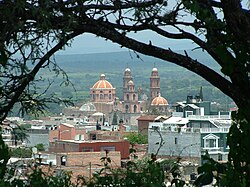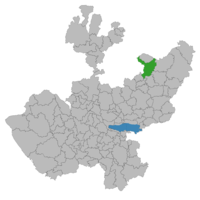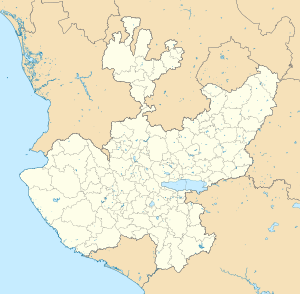Teocaltiche | |
|---|---|
Municipality and Town | |
 | |
| Nickname: Teocal | |
 Location of the municipality in Jalisco | |
| Coordinates: 21°15′N 102°23′W / 21.250°N 102.383°W | |
| Country | |
| State | Jalisco |
| Municipality | Teocaltiche |
| Settled | 1187 |
| Founded | 1530 |
| Incorporated (Municipality) | November 22, 1869 |
| Government | |
| • Type | Ayuntamiento |
| • Municipal president | Juan Manuel Vallejo Pedroza Morena |
| Area | |
| • Total | 933.5 km2 (360.4 sq mi) |
| • Town | 6.21 km2 (2.40 sq mi) |
| Population (2020 census)[1] | |
| • Total | 36,980 |
| • Density | 40/km2 (100/sq mi) |
| • Town | 24,580 |
| • Town density | 4,000/km2 (10,000/sq mi) |
| Demonym | Chapulin or Chapulines |
| Time zone | UTC-6 (Central Standard Time) |
| • Summer (DST) | UTC-5 (Central Daylight Time) |
Teocaltiche (Nahuatl languages: Teocaltillitzin "place near the temple") is a town and municipality in the central-western Mexican state of Jalisco. It is located in the northeastern highlands region of Jalisco, commonly referred to in Spanish as "Los Altos de Jalisco". The grasshopper or "chapulin" is a popular icon for the town.
Teocaltiche is one of the oldest settlements with Hispanic influence from the time of the Spanish conquest. The "Hospital de los Indios" (or alternatively "la Capilla") is a chapel in the city centre and the oldest standing building of Teocaltiche, built around 1546 by the Spanish conquistadors. The territory was conquered by Cristóbal de Oñate and Manuel de Ibarra in March 1530 on the order of Nuño de Guzmán.
- ^ a b Citypopulation.de Population of Teocaltiche municipality with localities


